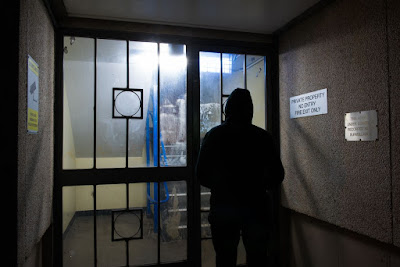Reviewed by Frank McKone
January 23
Direction – Simon McBurney; Co-Direction – James Yeatman; Set Design – Anna Fleischle; Costume Design – Holly Waddington; Lighting Design – Paul Anderson; Sound Design – Pete Malkin; Sound Associate – Benjamin Grant; Video Design – Will Duke; Dramaturgy – Maja Zade.
Performers:
Robert Beyer, Marie Burchard, Johannes Flaschberger, Christoph Gawenda, Moritz Gottwald, Laurenz Laufenberg, Eva Meckbach.
If bühne means “stage” and schau means “show”, then an unfortunate English translation of Schaubühne might be a theatre which stages only for show. When I add a translation of Complicité in to the mix, I start to wonder about the motivation for putting on Beware of Pity. Are we expected to be complicit – that is “involved with others in an activity that is unlawful or morally wrong”?
Certainly the style of this production looks terribly like “let’s be as avant garde as possible – that is, ‘favouring or introducing new and experimental ideas and methods’.” That translation’s unfortunate too, since avant garde became old-hat last century.
I actually fell asleep several times during the first hour of this two-and-a-quarter hours with no interval show. At times the story seem to be told by the man I took to be the actual story-teller, yet others who may or may not have been characters in the story – on separate microphones from different places on the basically bare stage – seemed to tell their own story, or somebody else’s; while sometimes it seemed that someone spoke the words of another character who was speaking her words at the same time.
I suppose if Complicité is about turning theatre topsy-turvy for the sake of it, that may not be unlawful. But for me, at least, it looked like show (including lots of sudden explosive noises which woke me up) for the mere sake of show – and that’s pretty much morally wrong theatrically, in my view.
Of course, having to concentrate on reading distant surtitles meant dividing my faculties between watching, listening, working out meaning and keeping up with the storyline – yet it seems that an English company choosing to work with German-speaking actors suggests that this is a planned zeitgeist for many audiences around the world.
However, does the form of presentation mean that the show was completely pointless? Did the interminable story have a theme of note?
What does it mean to beware of the pity expressed by a socially naïve young lower-class soldier, who gets himself into a mess by trying to do the right thing by a young upper-class wealthy partly-paralysed young woman, after innocently asking her to dance? Let’s consider.
In modern times in Australia he would have apologised when he realised the situation, she would have said something like “that’s alright – not your fault.” Her parents might say to him, “Sorry, we should have told you.” Any pity he felt, as any of us might feel, might make us feel a bit guilty and we might say, “Is there anything I can do?”
And yes, it is true that his apparent sympathy for her may turn into warm feelings for him on her part, which he may not be able to reciprocate – and so a complex story might begin. It might even end in her suicide. It might make a two hour movie or even a two-act play (with interval). It might even cause us to think about how an innocent action can lead to unforeseen consequences – a sad reality – but not to Beware of Pity like Shut the Gate with a sign Beware the Dog!
So I’m left seeing this play as being about history, rather than old-fashioned psychology.
Only in the final few minutes, after all those explosive emotional shows, do we get to what may be meant to be the nub of the story. The soldier must obey orders. Archduke Ferdinand of Austria is assassinated, the soldier must leave with no way to communicate with the distraught young woman. She kills herself; he faces the other kinds of explosions but survives World War I; his uniform ends up in a museum. In 1939 (the year when “The great Austrian writer Stefan Zweig [who] was a master anatomist of the deceitful heart” according to Goodreads, published his only novel) he tells his story to visitors seeing his uniform – and in some way this may be meant to be a warning about the foreboding World War II, when soldiers must again obey the Führer, whatever the consequences. And was the young woman Jewish? That might make sense.
Or that may be just my imagination. If I’m right, the production of Beware of Pity has some point. If not, it seems an odd play to present about such out-of-date attitudes and understanding of psychology – even for Jung or Freud.
So be a bit wary of Beware of Pity – you’ll need an open mind, but be ready to close your ears unpredictably while watching the surtitles like a hawk.
 |
| Photos by Will Duke |
© Frank McKone, Canberra
































